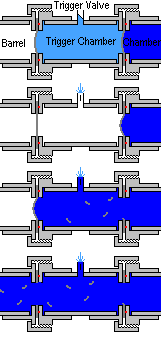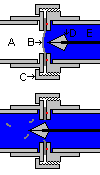Difference between revisions of "Triggered burst disk"
(error?) |
m (formatting fail) |
||
| (6 intermediate revisions by 5 users not shown) | |||
| Line 1: | Line 1: | ||
| − | + | [[Image:Triggered_burstdisk.PNG|frame|The firing cycle of a triggered burst disk]][[Image:Triggeredburstdisk2.png|frame|An example of a mechanically triggered burst disk; for the purpose of the example, D is a broad head.]] | |
| − | + | A triggered [[burst disk]] system allows the user to accurately control the time of firing, in one of two ways: | |
| − | The burst disks must be dimensioned to break somewhere between half and full chamber pressure. The trigger chamber is filled to half the chamber pressure, and then the chamber is filled to full pressure. When the trigger valve is opened, one of the disks is subjected to the full chamber pressure and ruptures, in turn overloading and rupturing the second burst disk. | + | == Cascade Failure == |
| + | Cascade failure systems consist of two burst disks mounted between the [[chamber]] and [[barrel]] of a [[pneumatic cannon]], with a trigger chamber in between and a trigger [[valve]] that either dumps said chamber to the atmosphere, or connects it to the main chamber. | ||
| + | |||
| + | The burst disks must be dimensioned to break somewhere between half and full chamber [[pressure]]. The trigger chamber is filled to half the chamber pressure, and then the chamber is filled to full pressure. When the trigger valve is opened, one of the disks is subjected to the full chamber pressure and ruptures, in turn overloading and rupturing the second burst disk. | ||
The design has the advantages of quick opening and full flow of a burst disk, and with the reliability and repeatability of normal [[pilot valve]]s. It has the other disadvantages of a burst disk system, as well as higher consumption of burst disks. | The design has the advantages of quick opening and full flow of a burst disk, and with the reliability and repeatability of normal [[pilot valve]]s. It has the other disadvantages of a burst disk system, as well as higher consumption of burst disks. | ||
| + | |||
| + | Implementations of this idea may be found here: [http://www.spudfiles.com/forums/triggered-burst-disk-by-pilgrimman-t12809.html] and here[http://www.spudfiles.com/forums/sctbdcv1-5-450psi-50mm-steel-cannon-updated-with-new-vid-t12103.html]. | ||
| + | |||
| + | == Mechanically Induced Failure == | ||
| + | Alternatively, the structural integrity of a single burst disk may be compromised, as by a broad head on a pneumatic ram or a resistive heating element embedded in the burst disk. | ||
| + | |||
| + | By damaging the burst disk, the bursting pressure of the disk decreases, until the pressure in the chamber is sufficient to destroy it. | ||
| + | |||
[[category:valves]] | [[category:valves]] | ||
Latest revision as of 23:05, 27 August 2009
A triggered burst disk system allows the user to accurately control the time of firing, in one of two ways:
Cascade Failure
Cascade failure systems consist of two burst disks mounted between the chamber and barrel of a pneumatic cannon, with a trigger chamber in between and a trigger valve that either dumps said chamber to the atmosphere, or connects it to the main chamber.
The burst disks must be dimensioned to break somewhere between half and full chamber pressure. The trigger chamber is filled to half the chamber pressure, and then the chamber is filled to full pressure. When the trigger valve is opened, one of the disks is subjected to the full chamber pressure and ruptures, in turn overloading and rupturing the second burst disk.
The design has the advantages of quick opening and full flow of a burst disk, and with the reliability and repeatability of normal pilot valves. It has the other disadvantages of a burst disk system, as well as higher consumption of burst disks.
Implementations of this idea may be found here: [1] and here[2].
Mechanically Induced Failure
Alternatively, the structural integrity of a single burst disk may be compromised, as by a broad head on a pneumatic ram or a resistive heating element embedded in the burst disk.
By damaging the burst disk, the bursting pressure of the disk decreases, until the pressure in the chamber is sufficient to destroy it.

